The Reconstruction of the Southwick Studio
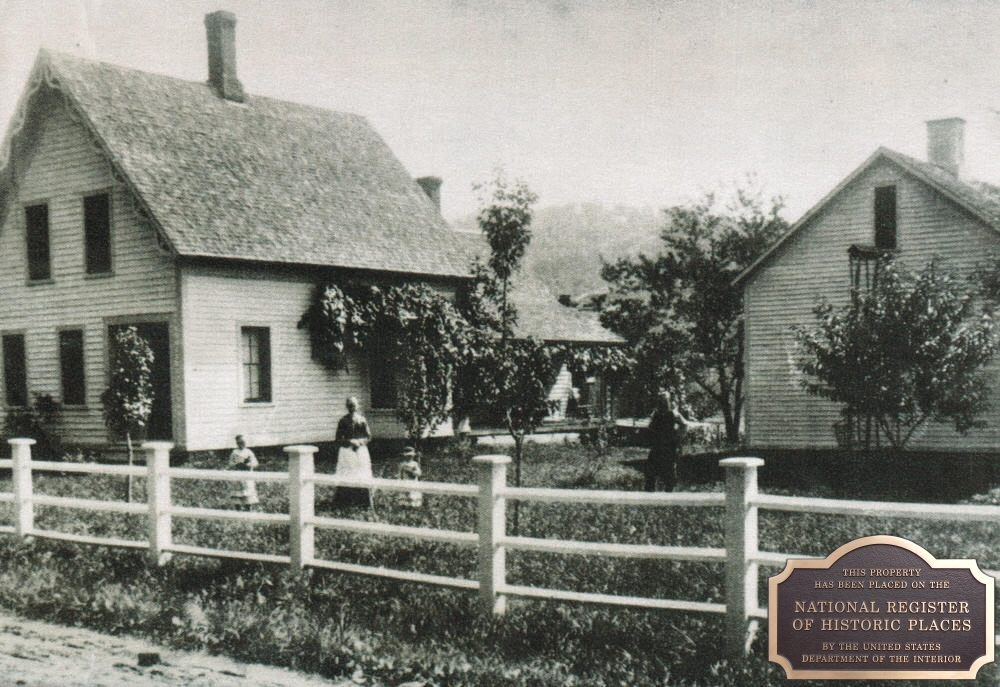
The Southwick House circa 1850. Note the barn on the right in its original position and the missing bedroom off the side of the main house.
The people in front are not known but are likely the Joseph Taylor family who originally built the house.
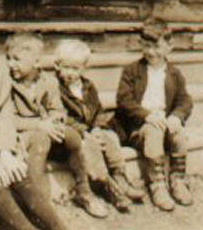
Herbie, brother Josh, and me.
The picture above was taken in the early 1850s. It looked about the same in 1934 when Robert Strong Woodward purchased the property and began renovations. All of the buildings were separate from each other. The major object of the Woodward reconstruction was to tie all the buildings together for wheelchair accessibility and move the barn which blocked the view of the valley and mountains.
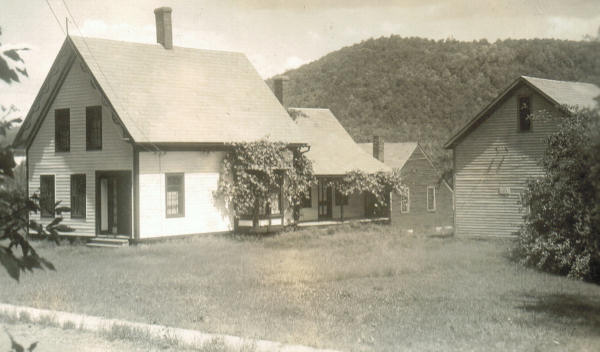
All buildings are separate: barn on the right, main house on the left,
then the kitchen section,
then the blacksmith shop in distance. Picture was taken in 1934."
All old country houses of this era had a large back porch for "sitting out" on hot summer evenings. There was a sidewalk at this time, but the roadway was gravel, unpaved, and hard to walk on barefooted. The blacksmith shop (current studio building) seen in the far distance was to be raised up 5 or 6 feet during the Woodward reconstruction.

This old template for the roof cornice was found in the studio
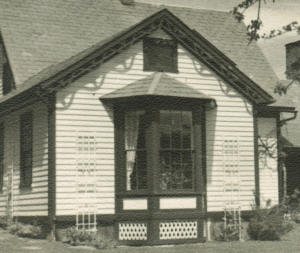
Cornice on new bedroom ell.
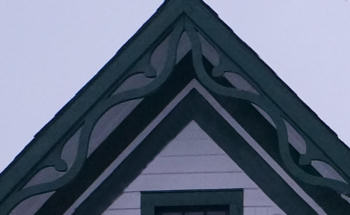
Roof cornice on main house.
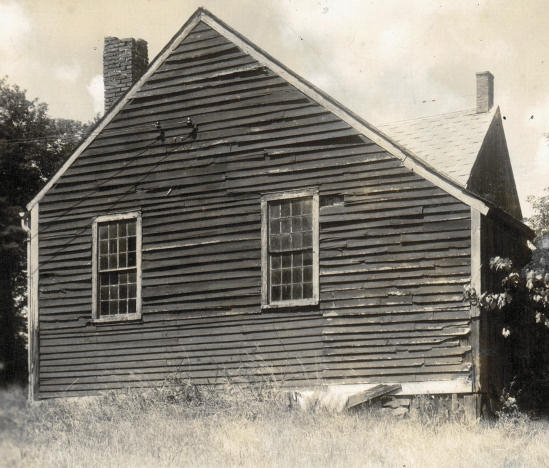
Blacksmith shop (now the studio) in original position Carriage shed roof shows behind.
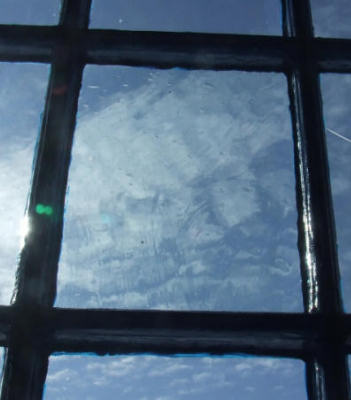
Panes of hand-blown glass in studio windows today
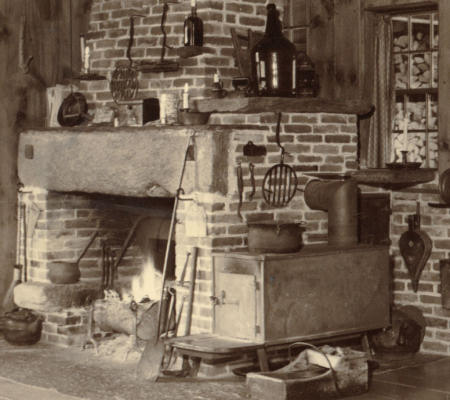
The fireplace and stove were the main source of heat for the studio.
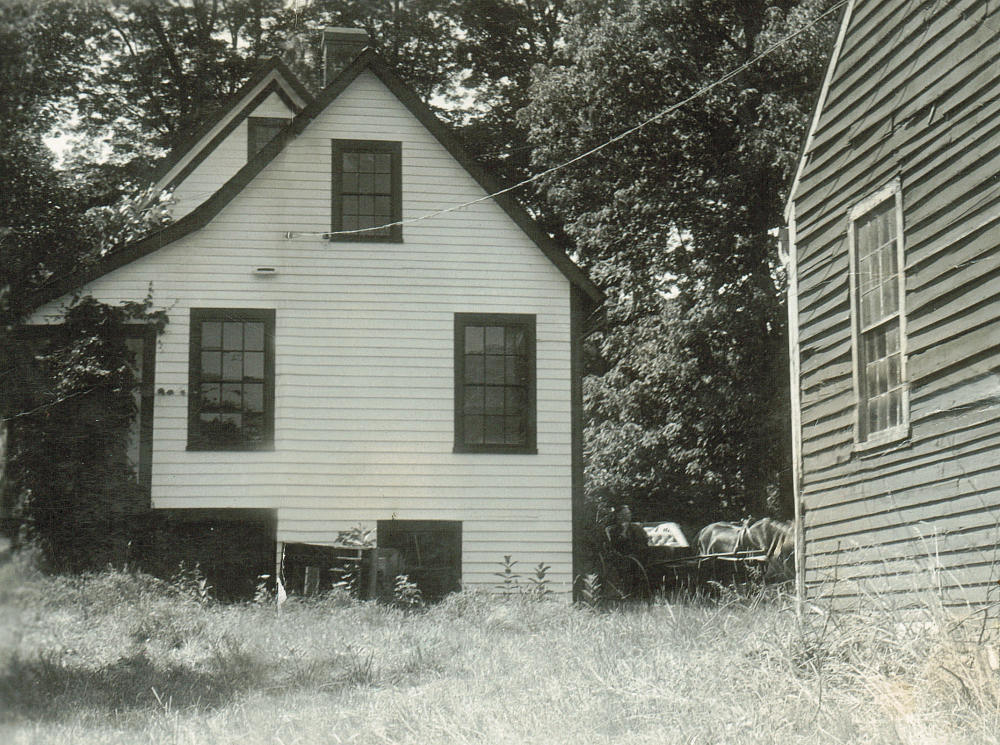
This shows the kitchen area of the house. The chicken house will be inserted here between the main house and the blacksmith shop on the right.
The picture above shows the blacksmith shop on the right sitting on the ground and the house behind it on the left. The Woodward reconstruction plan was to connect these two buildings. RSW can be seen in his buggy (being pulled by Trigger) in the background between the buildings.
Note also the beehive entrance slit into the attic clapboard just below and to the left of the attic window. Old Henry Southwick, the previous owner, kept honey bees for the dual purpose of producing honey and to provide pollinators for trees and vegetables. In the summer the hives were outdoors, but were moved into the unheated attic space in front of the slot shown. This protected the bees from the most bitter cold during the New England winter months.
The low down window at ground level shown here is the little window still existing into the crawl space off the cellar under the current laundry room.
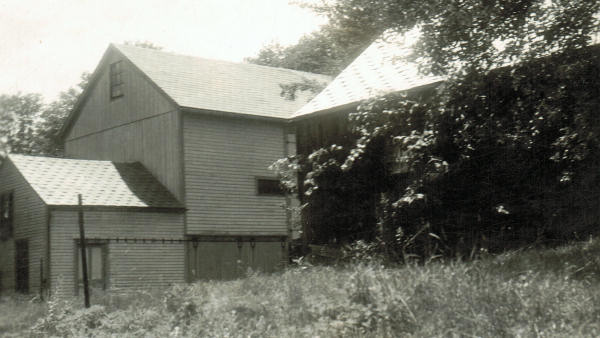
Chicken house, left, attached to the barn. This is to be removed and attached
to the main house. Blacksmith shop is on right.
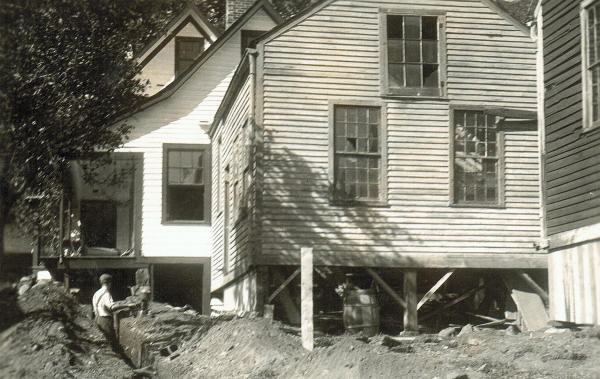
Chicken house has been moved from being attached to the barn to its new position
in between the house and the blacksmith shop.
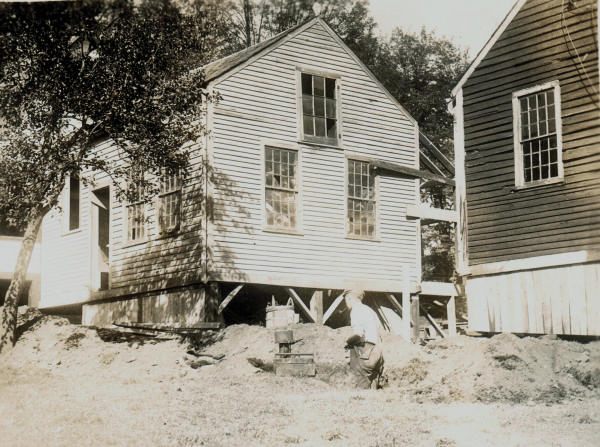
Digging sewer line trench.
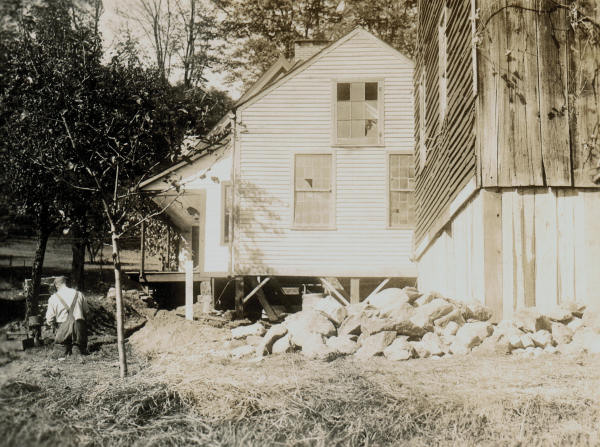
Little Gallery (old chicken house) in position.
The open area under the chicken house was later closed off but left open as a crawl space from the cellar to allow access for water and heating pipes as well as the electrical connections between the house and the studio.
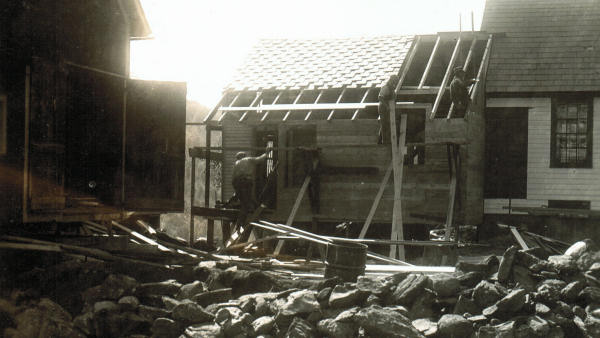
Chicken house under renovation. North side. Carriage house is on left. Blacksmith shop
(not seen from this angle) is in between these two.
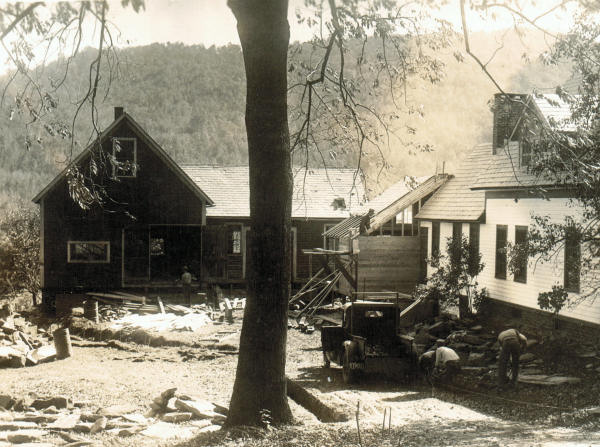
Building of the service yard. Chicken house inserted between house and blacksmith shop.
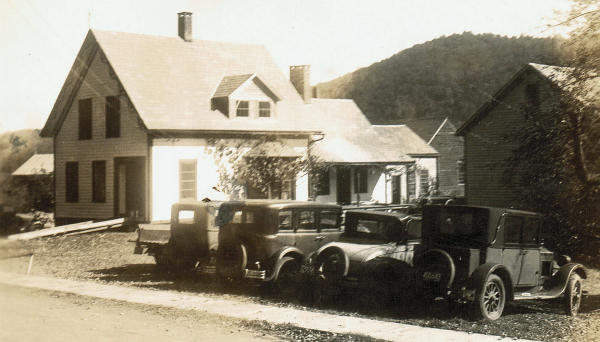
Cars of the workmen. Barn still in original position. Barn at the far left is
that of
"Old Man Gould" (Herbie's grandfather), a milk farmer and next door neighbor.
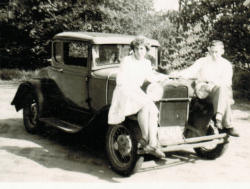
My first car and my first girlfriend.
I paid $50 to the legendary Chet Willy (the Charlemont second-hand car salesman) for it when I was in high school. Most of the cars on the roads in those days were Fords. Henry Ford's words rang true. "Any man making a good salary will be able to afford one of my cars." These men working for RSW during these days of the Great Depression were, indeed, making a good salary, working by the hour to completely rebuild the old Southwick House and blacksmith shop. All of the carpenters, plumbers and electricians doing this work have long since died. Their masterful work has held up well over the intervening years.
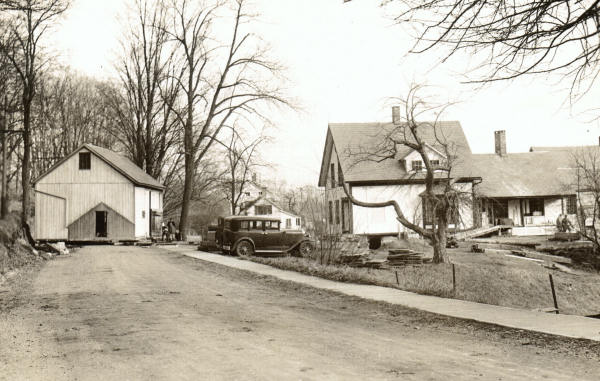
Barn being moved down Upper Street to new lower location on the north side of the house
property. Note where the chicken house was removed from the barn.
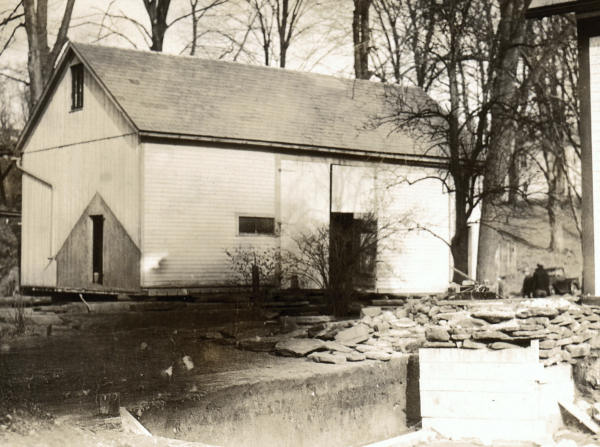
The cement foundation in the near foreground is the base where the bedroom ell will be built.
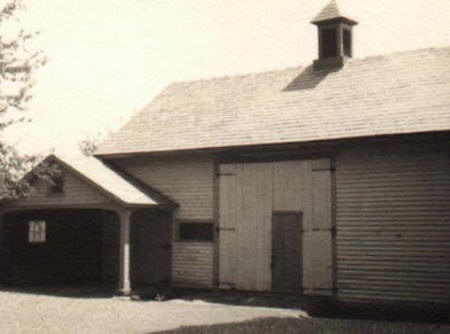
Barn in place. The weather vane on the roof was added later.
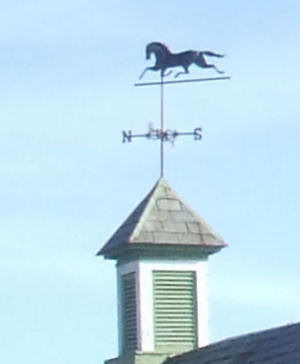
Present day view of cupola and weathervane.
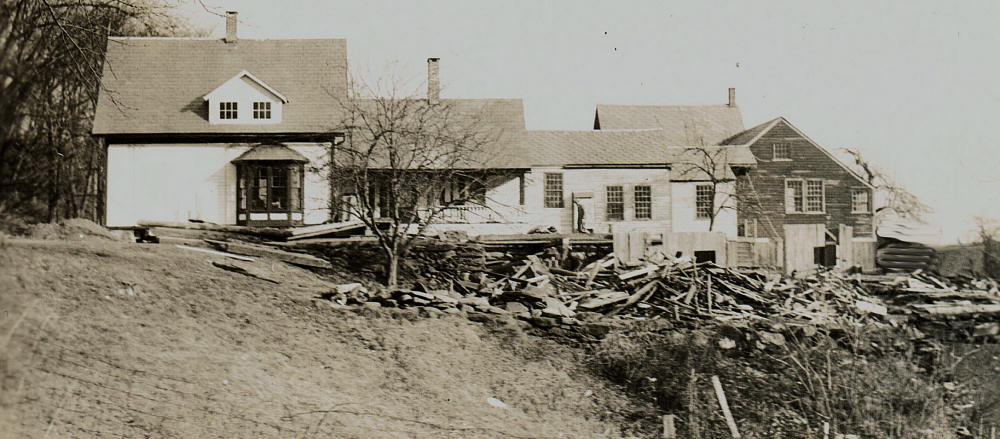
The mess left after the barn and chicken house were moved.
The apple tree in the picture was a Yellow Transparent but that, too, has long been gone. The area remaining from removal of the barn was made into a cement terrace beneath which was a storage area for buggies and sleds.Where all the boards are piled up was to become the Lower Terrace, a place for picnics and musical concerts.
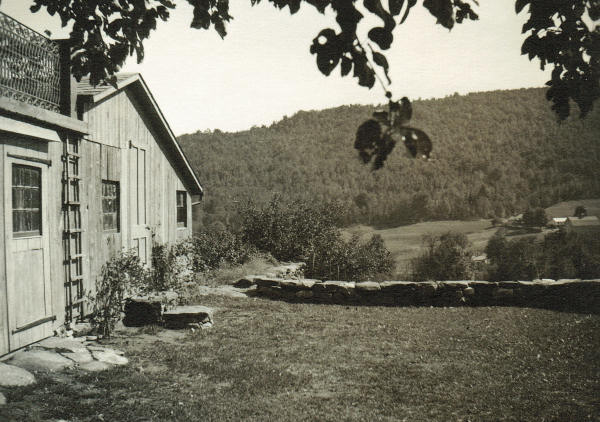
Formerly the barnyard on the south side of the old barn.
Click play below to hear the 4th movement of Beethoven's 6th Symphony.
Click here to play music
The next few pictures show additional views of the reconstruction. Even in those days of the Great Depression this was a relatively expensive project. The cost of this was provided to the artist by a wealthy woman, Mrs. Ada S. Moore, the widow of the owner of the American Can Company. It was common in those days for an artist to have a "patron." Early on in his career, way before the time of my working for RSW, this lady had taken an interest in him and his work. She had set up a trust fund to provide him with a nurse, a housekeeper and a handyman for life, so that he could continue his painting without financial worry. When he suffered a fire and lost his first studio, Redgate, and then a few years later lost his home and second studio located on Woodward Road, Hiram Woodward Mrs. Moore agreed to pay for the reconstruction of the Southwick house. Her support made possible all of the changing of levels of the different separate buildings, and making the entire house and studio handicapped accessible.
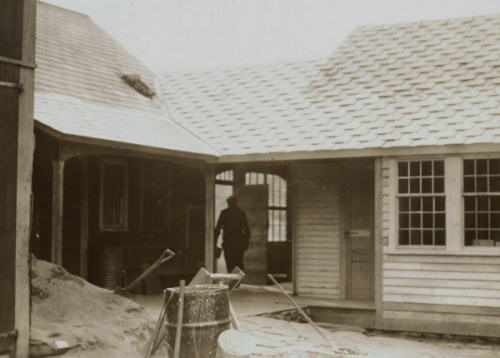
The Little Gallery (the chicken house) in place.
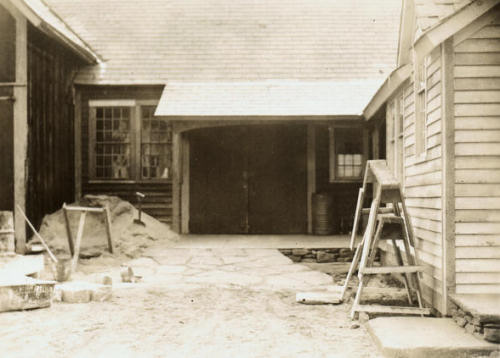
Little gallery (chicken house) on right.
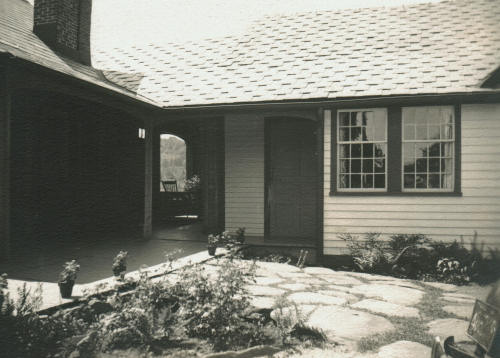
Little Gallery in place, front slate entrance to studio.
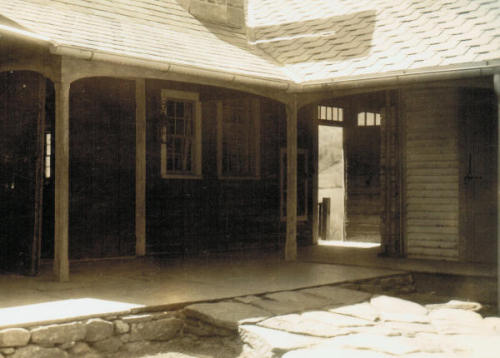
Front entrance to studio. Connection has been made to house and little gallery.
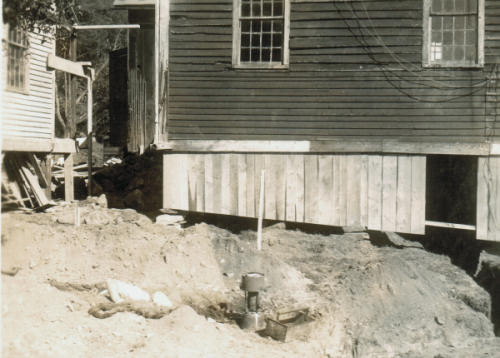
Entire blacksmith building raised up 5-6 feet.
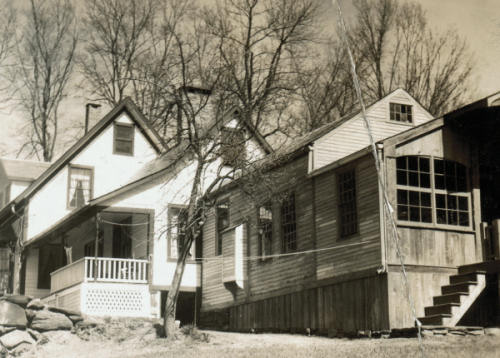
Renovations nearly complete.
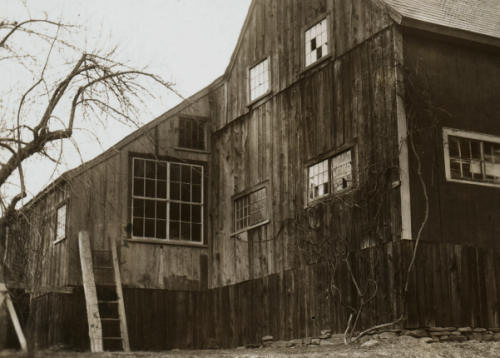
North side of the studio. North window not yet extended.
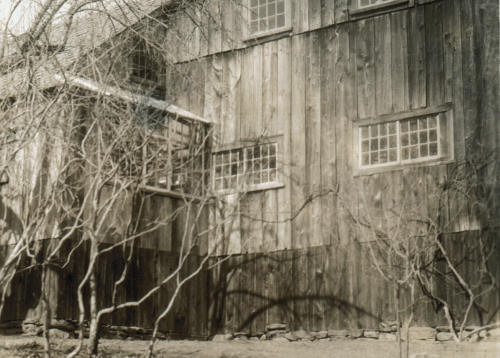
North window now built out with skylight.
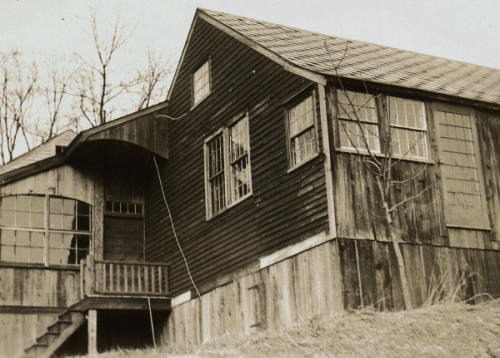
Southeast side of the studio. Balcony no yet added.
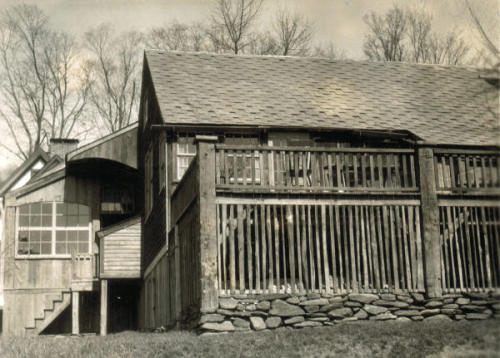
East side of the studio with balcony now attached.
Observe the picture above which shows the completed back side of the studio as it ended up after the Woodward reconstruction. The studio balcony shown here collapsed after a heavy snow storm the year after we took possession of the property. It was replaced at that time with an additional stairway down to the ground level (which was, of course, not needed by RSW in a wheelchair.) The large window shown in this picture is still a storm window put into this space every fall to winterize the incline area from the house to the studio. Only an artist could ever have designed this architectural lay-out.
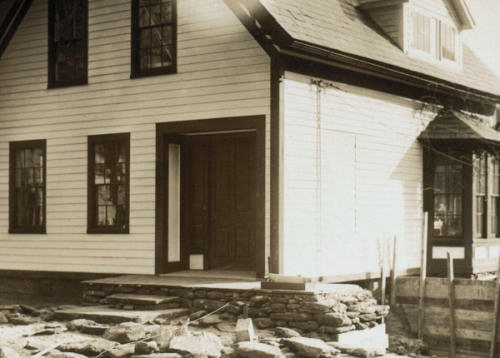
House front entrance. Bedroom ell not yet constructed.
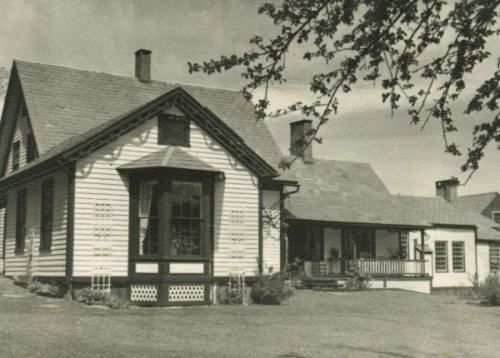
The bedroom ell has been added to the front of the house.
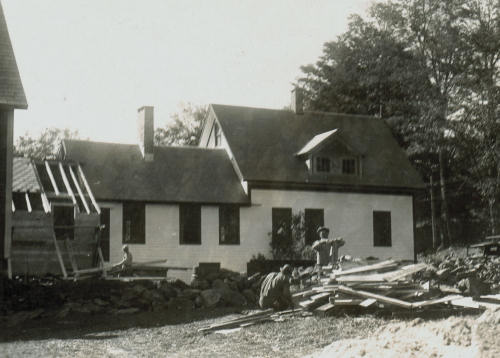
Service yard development.
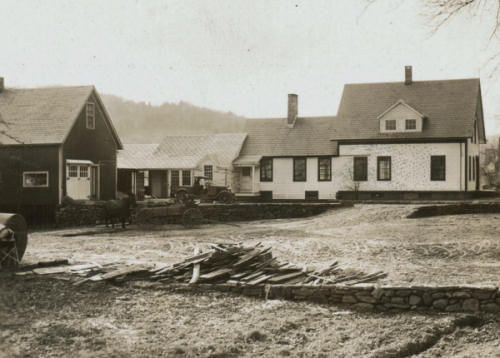
View of yard construction..
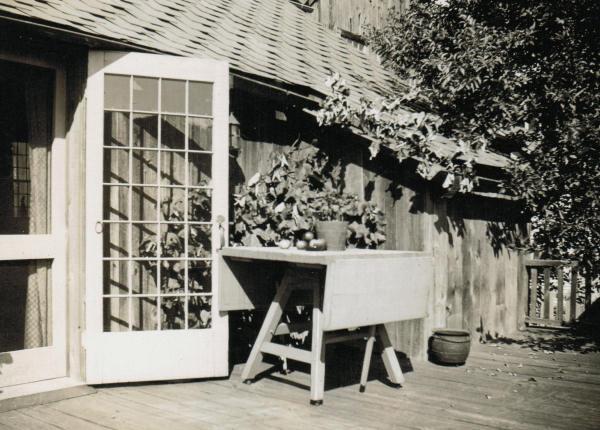
Balcony porch floor with door entering the studio.
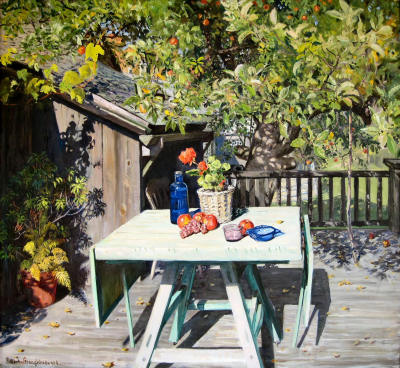
Sun on the balcony, an oil painting made in 1946.
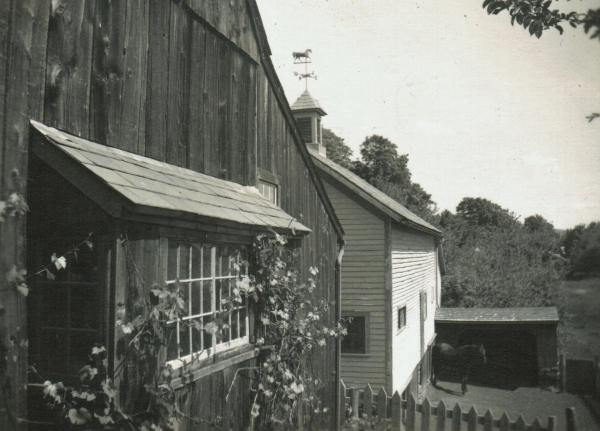
Rear of carriage shed showing extension added for Packard.
Finished barn in new position with Trigger in the barnyard.
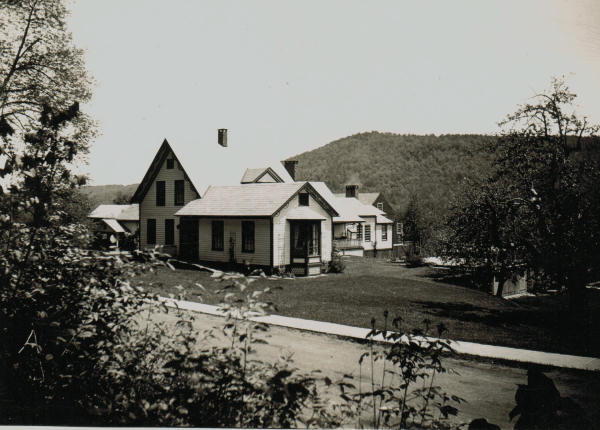
Balcony floor with door entering the studio.
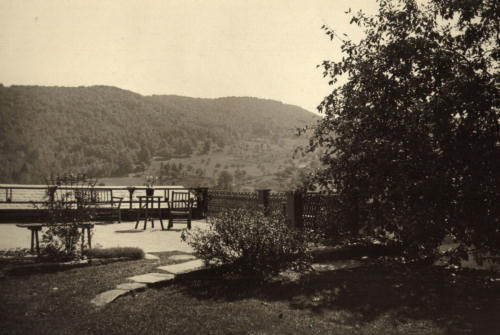
View from the RSW's bedroom window - the cement terrace and Putt's Hill.
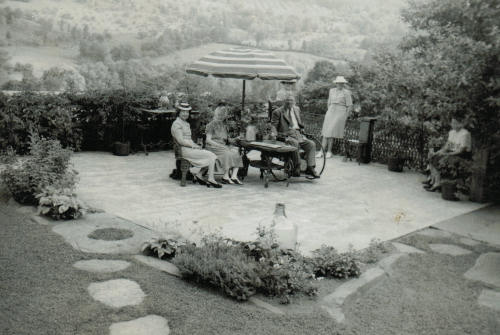
Cement terrace: RSW and guests.
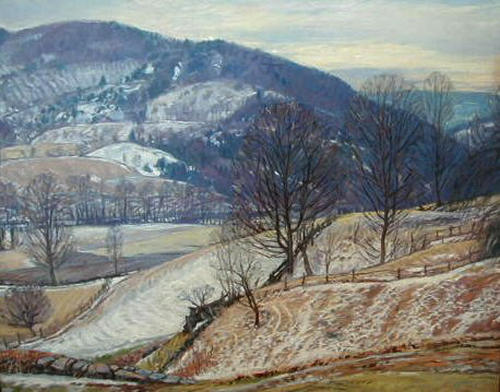
Out The Bedroom Window An oil painting looking south towards Ashfield.
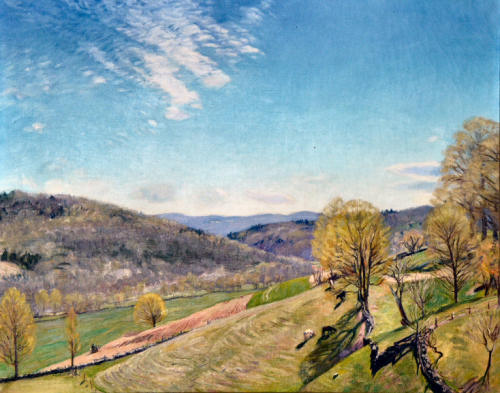
Unnamed #45 Oil painting of the view from RSW's bedroom window.
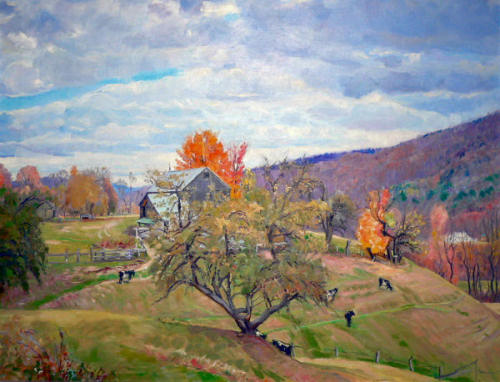
Unnamed #6, the view northeast from the studio balcony.
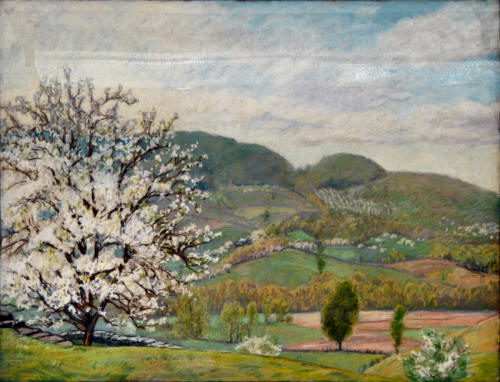
Unnamed #44: The barn removed, this was RSW's view toward the valley.
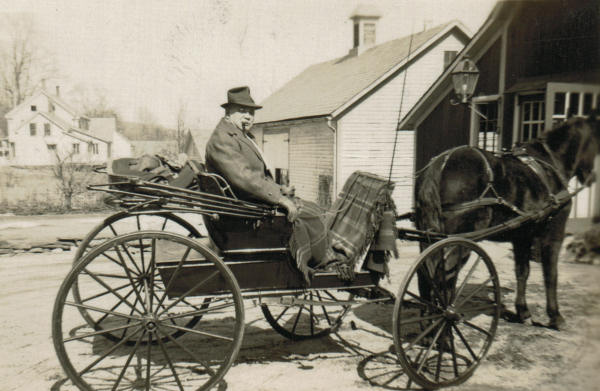
RSW as Clerk of the Works.
Robert Strong Woodward was the sole designer of all of the changes made during the reconstruction. He gave up painting entirely during this two year period, devoting all of his time and effort to the overseeing the work. He was constantly present at the site and I remember him sitting in his wheelchair or buggy smoking a Cuban cigar, which he would hold out in his fingers at arm's length to judge the horizontal levels or vertical "plumbness" of the building changes being made.
The following sketches were made by RSW during the reconstruction phase of the Southwick House as architectural designs for the builders to follow as they did their work. The sketches were removed from one of his sketchbooks for inclusion here. The sketeches are all easily recognized to one familiar with Our Old House.
The following sketches were made by RSW during the reconstruction phase of the Southwick House as architectural designs for the builders to follow as they did their work. The sketches were removed from one of his sketchbooks for inclusion here. The sketeches are all easily recognized to one familiar with Our Old House.
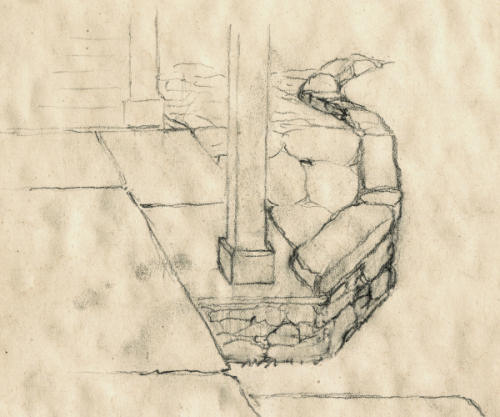
RSW's sketch the stone work for the front door ramp.
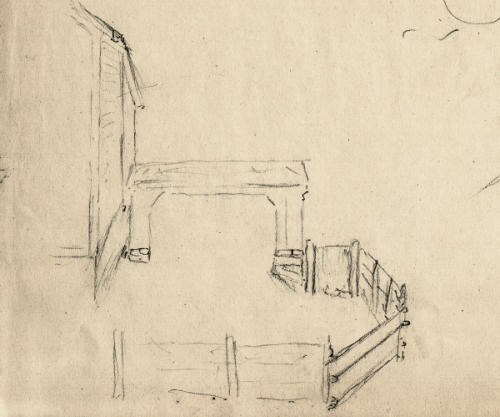
RSW's sketch of the barnyard.
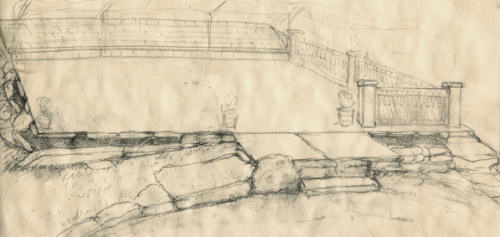
RSW's sketch of the front terrace.
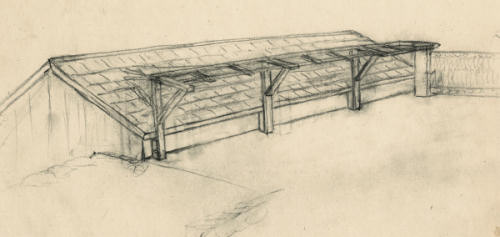
RSW's sketch of the terrace grape arbor.
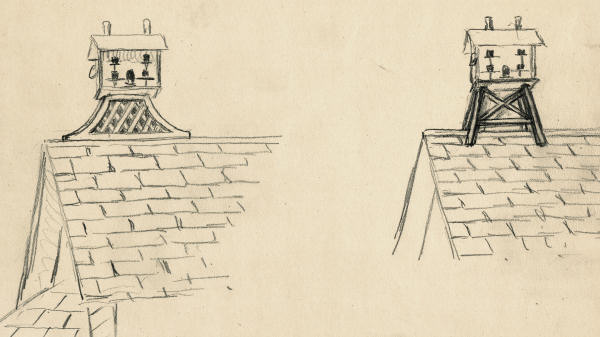
RSW's sketch of the Birdhouse on top of the bedroom addition.
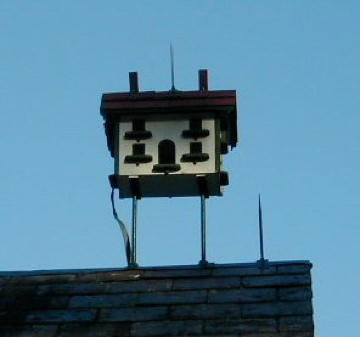
Photo of the finished birdhouse.
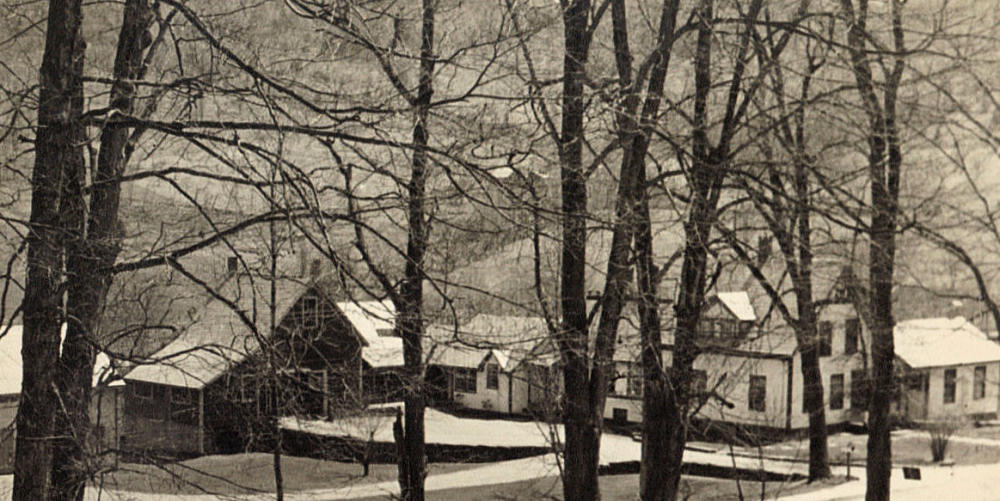
The Southwick home and studio after reconstruction. Photo by F. Earl Williams.
The above shows the final result of the Woodward reconstruction. Left to right: the barn which was moved here from the other side of the house, the carriage shed which is in its original position but raised up about 5 feet, the studio which is in its original position but greatly modified and raised up about 5 feet, the chicken house which was removed from one end of the barn and moved into position between the house and studio, the house which had dormer windows built on the second floor, and finally the RSW bedroom ell which was new construction added on to the front end of the main house. All the roofs were covered with slate stone.
As completed, RSW could go from his bedroom area through the main house, to his studio, to the Little Gallery (the chicken house), and to the carriage shed in his wheelchair. He could see up and down the valley from his studio and he could see up the valley from his bedroom. And he could paint the views from both places ... which he did.
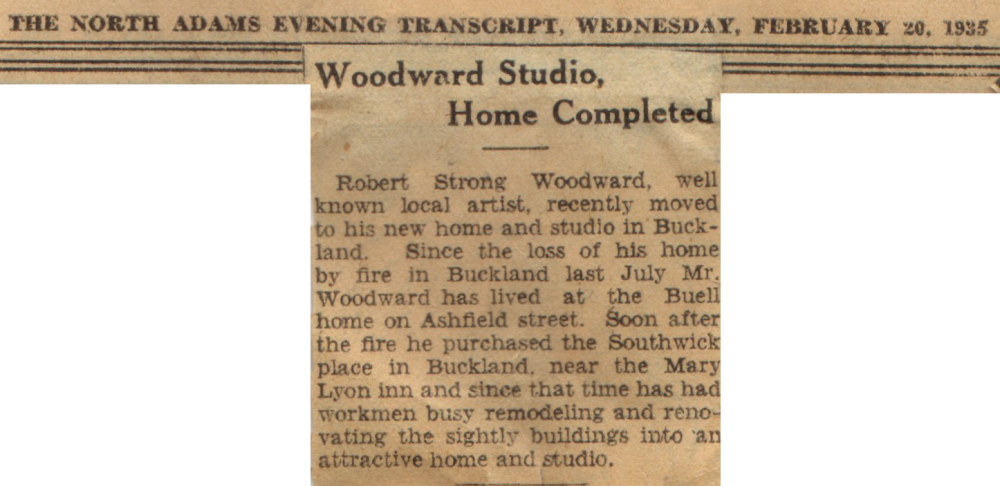
The North Adames Evening Transcript,
Wednesday, February 20, 193
Woodward Studio, Home Completed
Robert Strong Woodward, well known local artist, recently moved to his new home and studio in Buckland,. Since the loss of his home by fire in Buckland last July Mr. Woodward has lived at hte Buell home on Ashfield street. Soon after the fire he purchased the Southwick place in Buckland, near the May Lyon inn and since that time has had workmen busy remodeling and renovating the sightly buidings into an attractive home and studio.
MLP
2013

